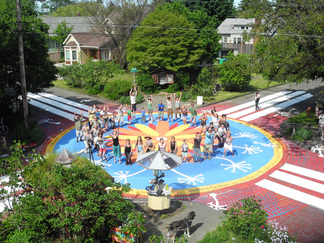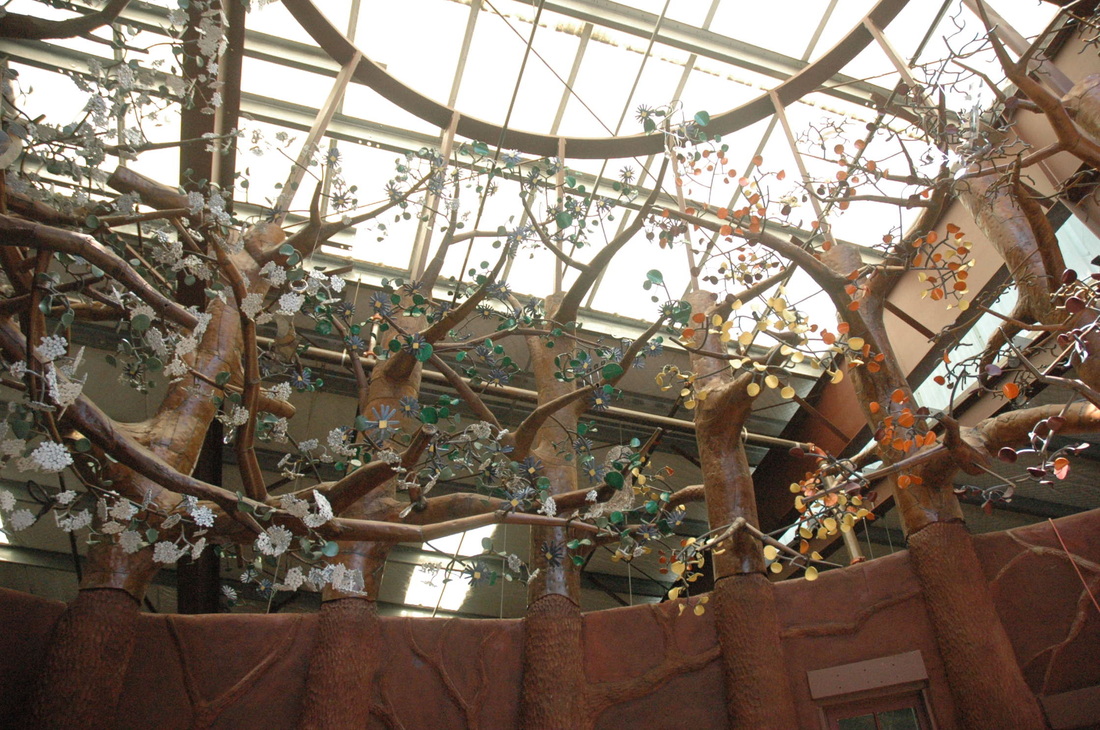Published in Communities Magazine, Summer 2014 issue
| Dignity Village Phase 4: The Leading Village, sketch by Mark Lakeman |
We had taken half a day to dialogue, share a meal and spend some time to explore longest-range possibilities. It was all so simple, but then all we did was talk about the life that we were already living in our own Portland, Oregon neighborhood. The question had really become, “How do we inspire people everywhere else?” At the end of our half-day workshop called “What Would World Peace Look Like?” someone had said: “The revolution we seek is one where people will act with what they have, where they are, right now!” Another person said: “And everyone everywhere can do this!” Then we all went outside, as if into our own drawing.
For our young design-activist group, known from the start as communitecture (community + architecture), growing up in the cradle of design-activism that is Portland, Oregon, it had become ridiculous not to intend to create a better world. We were already standing upon the work of giants, in some cases our own parents. With urban growth boundaries protecting perimeter farmland all around Portland, the spectacular new public square energizing our city, multi-modal transit expanding across the region, vast wildlife sanctuaries established to provide open space for all species, and citizen power at a zenith, we had to ask ourselves, “What more is possible, and how can we inspire more to happen in the world?” We began to answer our own questions, the more we worked with communities across the city, and the answers began to multiply.

Our first community Tea House project, installed without permission in a neighborhood zone, brought thousands of people together in the summer of 1996. Then we empowered our neighborhood to transform a street intersection into a public square, and made it legal for everyone else in the city to do it too. After that, we created an ephemeral community gathering place that went across the city, facilitating relational networks everywhere until on June 21st, World Peace Day of 1997, when we created a human linkage of people holding hands around our city. Lots of people wanted to know what we called ourselves.
When we finally chose two names, we used them to describe two modes of action in our group. One was City Repair, the place-making activators who in a few years would create a nonprofit organizational structure for itself. The other name was communitecture, which even more quickly became an economically self-supporting model of collaborative design activation.
Though the two parts of one activist culture have remained involved and mutually supportive over the years since, communitecture has gone on to support larger-scale initiatives and projects that cover a much wider spectrum of communities and ideas. Many diverse communities have been attracted to work with us because we use design as a means to build community.
The kinds of projects that we are fortunate to help create can include radical buildings made entirely of natural and recycled materials. Most of these are urban, and they are always ideas that spring from people who are creating a setting for some new form of community. For instance, The ReBuilding Center, an 80,000 square foot facility that makes recycled materials available for low cost, is a project of and for the community of people who work in it. Each person who works there has power in their shared-power culture, they all earn a living wage, and each person has full health and dental benefits, as do their families. As design-activists, our interests shouldn’t stop with the shape of a building. It should matter most to us that people are empowered where they live and work, and that they are able to shape their own future while they benefit from what they do with their time.
Our main driving choice, though, is to work with people who want to be involved in designing and also building their own community places. In this way these places become a reflection of their living culture. Our recent work with the CAPACES Leadership Institute, a youth leadership development project founded by Cesar Chavez, has resulted in an exuberant building made by that community that is now the most energy efficient and artistically expressive office building in the US.
The way that we work is first to see that as citizens our task is to be part of a shared cultural fabric with other people, businesses, nonprofits and institutions. We must not merely be a business looking out for our own interest; in fact it’s vital that we act from a place of seeing that we are already a connected ecology. Another huge responsibility we see that we share is to restore and strengthen ecological feedback loops in our local community ecology. So communitecture intends local restorative effects as an outcome. This means cleaning up brownfield sites, developing stronger communication networks and relationships, engaging youth in projects, and creating urban agriculture networks.
If we are asked to help with a project, it’s not merely a job for us; it must also be a long term commitment to our community with the expectation that at the culmination of a process we will all have more friends than before. So, when we help facilitate design dialogues for local cohousing communities, we are in it to help create the kinds of places that we also want to inhabit, for the communities that we intend will surround our own lives.
In terms of our business model, it is a creative hybrid that grew out of loving our work and trusting each other. When it came time to develop official systems for payroll and accounting, we kept it simple, based on trust. As the most experienced member of the team, I was happy to be the one to who registered our name and established business accounts. At that time, our team was young and mobile, and since I was most stable, the ownership roles were established as my responsibility, to hold the systems in place while other people could come and go.
So what has emerged today is a trust-based model where the present team makes choices together, collaboratively runs itself, maintains a very strong and attractive ethic of community service, and pays itself. In fact, though the official ownership is held in my name, the team decides what I am paid. Since we are a kind of benefactor-co-op, a great depends upon my sharing of power, and the value of this aspect of our model can’t be overstated. The fact that I utterly believe in and rely on my team, and they see that I trust them, is what transcends our legal configuration. Perhaps it is a transitional form of some sort.
With this kind of trust-based approach and cultural mission, it’s possible that we could use almost any kind of official structure and still thrive. This attitude helps us stand for what we are committed to, and because of this our larger community has always embraced us with positive story-telling and advocacy for our services, donated space, recycled computer systems, all needed materials for our desks and office environment, and quite a lot more.

While most architects are passive, waiting for someone to pay them to use their creativity, we will often creatively engage a situation whether we are paid or not. Therefore we can also initiate strategic projects that are socially based, politically charged, ecological, celebratory, with all manner of innovations, and continue to be off the leash creative agents for a better world. This ethic is expressed in our active design support for numerous homeless village initiatives up and down the Pacific Coast. In these kinds of projects there is never a cost for design support, which creates more goodwill in the world than can be known.
It’s also important to acknowledge that our cooperative ethics and goals can come into conflict with long standing competitive structures and behaviors. The conflicts can come in various forms, both internal and external. Internally, since architecture training is usually set in a competitive context, it can be challenging for interns to learn how to collaborate without needing to have their own way, just as it can be difficult for a mentor not to be dominant. Building confidence can be a challenge in any situation, but people find it much easier to help each other, as they develop strong communication skills in a cooperative environment.
What can you do about such polarities except to try to learn together? In fact, our commitment to cooperate does sit strangely for a profession that has been deeply educated to compete against itself.
Our attitude towards our community is essentially this: we interact with our city as if we are villagers that share the same place. The initiatives that we support can come from anywhere in the community. As villagers our responsibility is to give each community and their ideas the support and momentum that they deserve. With all that we give to our community, our relationship with our community only deepens. In fact, as we continue to see our community as a living ecology, and as we heal broken feedback loops, we build upon the stories of sharing and constructive action. Over and over, we see the power of story bringing benefit back around to us when we release our grip on the “return” on our efforts. Some have called this being “in alignment with the economy of the universe,” the way that nature showers us with gifts.
With all of the personal and community-scale benefits that we have witnessed, with communities in Portland stabilizing, and the increasing levels of excitement and creativity all around us, it does feel as if we are in alignment with great principals and a more worthy form of economy. Something wonderful has already been happening for a long time, and now we can design in accord with it while our way of living and livelihood become the same.











 RSS Feed
RSS Feed

